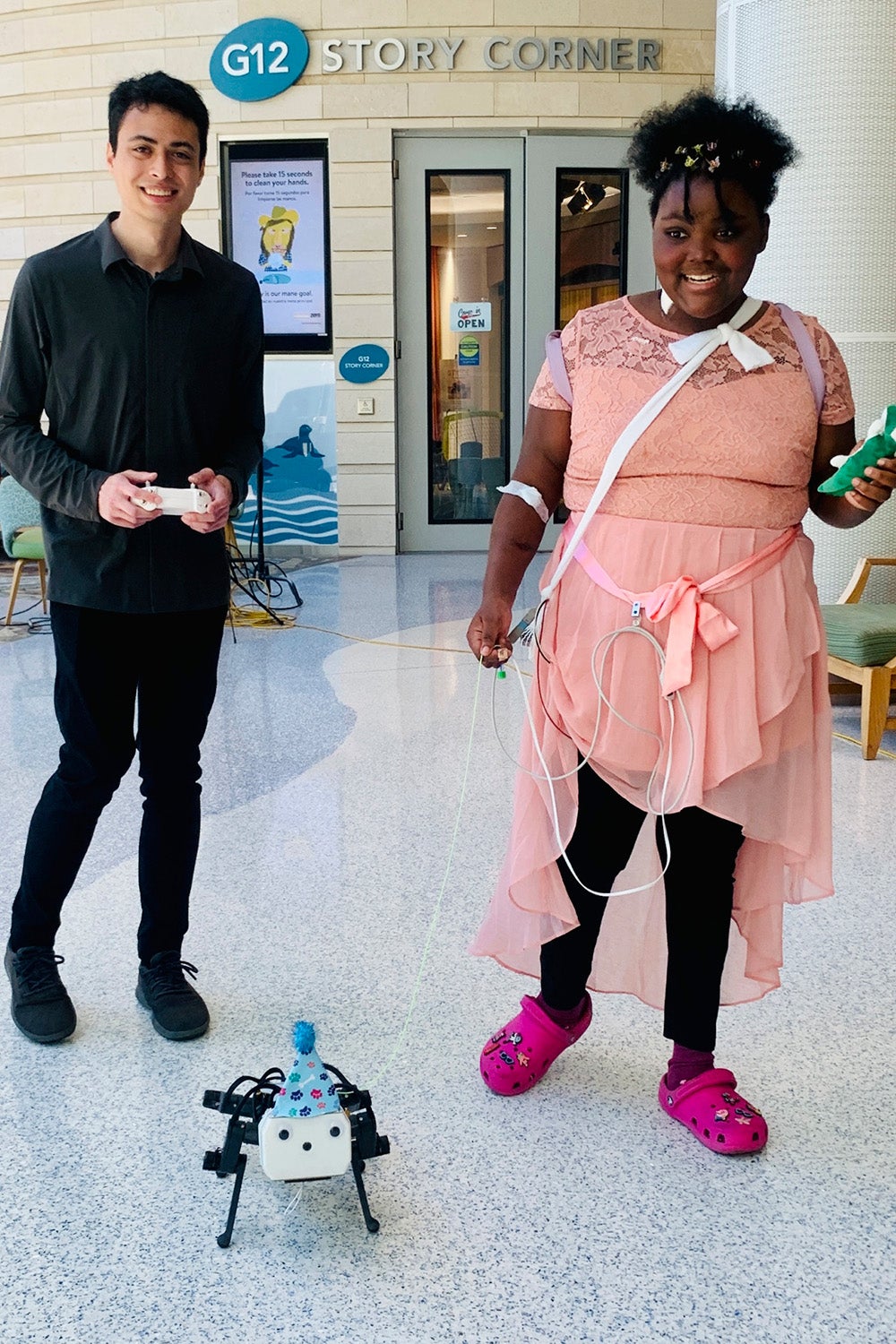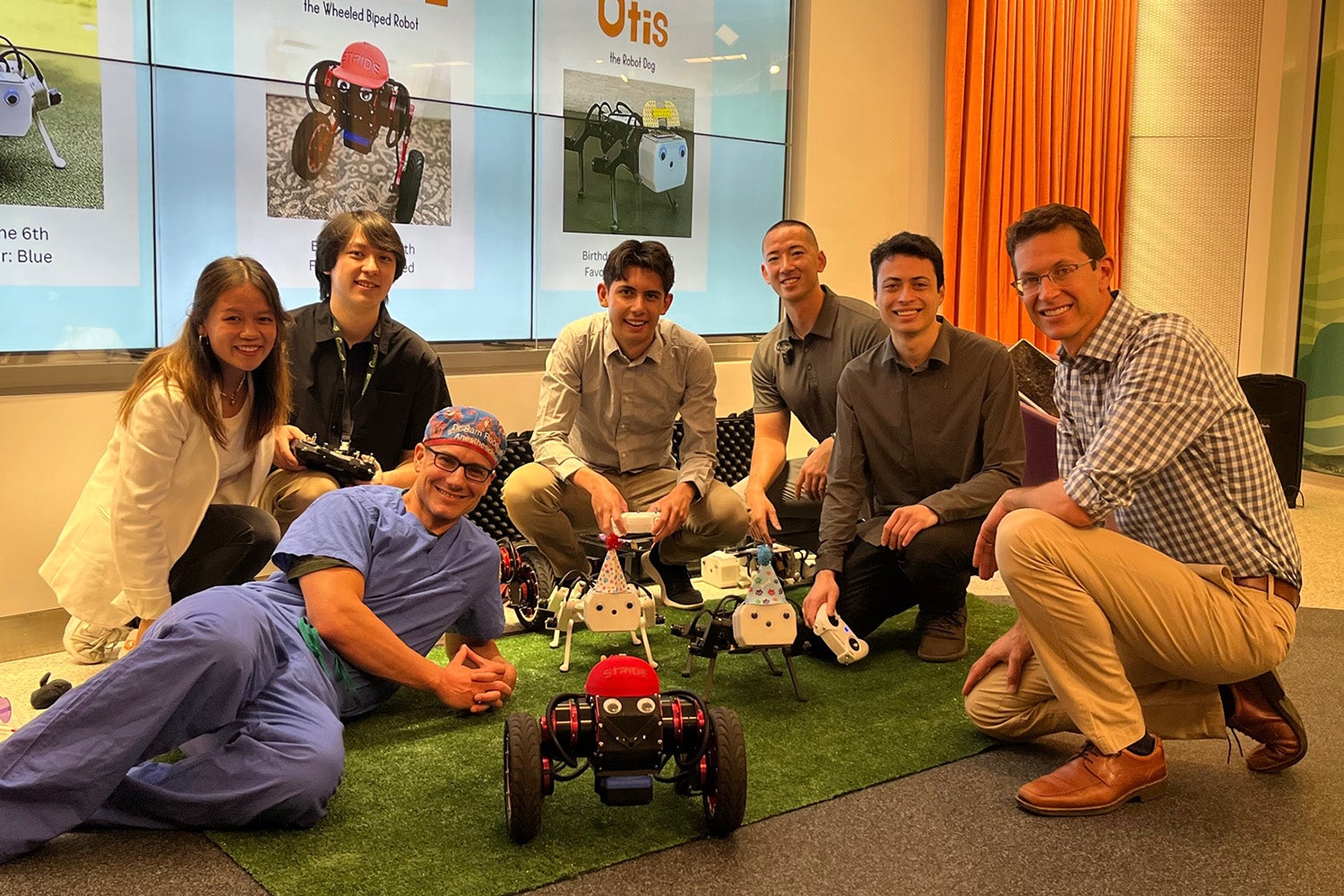Robo-dogs unleash joy at Stanford hospital
Stanford students, researchers, and doctors, in partnership with AI and robotics industry leaders, recently demonstrated the playful bots for patients at Lucile Packard Children’s Hospital.
New Stanford-developed robotic dogs that can walk, jump, wag their tails, and even dance may one day help put pediatric patients at ease during their hospital stays.
On Friday, patients at Lucile Packard Children’s Hospital (LPCH) at Stanford Medicine participated in a playful demonstration of the mechanical pets. The event took place at the hospital’s Story Corner, where children played with the robots. Patient Tatiana Cobb, 12, was particularly impressed with one dog named Otis.
“He reminds me of my own dog at home,” she said. “He is smart and is able to dance with me. He makes me feel like I’m back at home with my own puppy again and not in my room just watching TV and taking medication.”

Patient Tatiana Cobb, 12, plays with a robotic dog named Otis, operated by Stanford computer science student Gabrael Levine. (Image credit: Stanford Medicine Children’s Health)
The goal of Friday’s demo was for the Stanford students and researchers who created the dogs to begin studying how the bots interact with pediatric patients and could potentially improve their clinical experience.
“Many kids respond really well to novelty, especially as it reduces their anxiety,” said Teresa Phuongtram Nguyen, a resident in anesthesiology at Stanford Medicine. “One day these social robots may accompany kids in the operating room and around hospitals to give them a better inpatient experience.”
Developing technology
For the past several months, Stanford undergraduate engineering students built the dogs in a seminar focused on incorporating artificial intelligence into robots. They were created with support from the nonprofit Hands-On-Robotics, co-founded by Nguyen and Stuart Bowers, a former vice president at Tesla with extensive experience with AI and machine learning.
The robotic dogs, called Pupper, are an updated version of another robotic dog developed at Stanford called Doggo, an open-source bot with 3D printed components that anyone could build on a relatively small budget. The Pupper robots at Friday’s demo are not autonomous, but rather operated by a handheld controller. They were also designed to interact with humans.
“We want to use these for education, so we don’t want them to be too big or too powerful,” Bowers said. “They’re designed to be small, playful, and safe.”
He explained that the joints of the original version of the robot did not provide feedback. As a result, an operator could tell the machine where to move, but wouldn’t know if the order was performed or not. One of the core design decisions for the new robot was to improve the joints to make the dog more obedient.
The more responsive joints also make the pups more fun to play with. “You can actually push on the robot and it’s compliant. You can overpower it,” Bowers said. “That makes it a lot more robust, so it doesn’t break as easily, and it’s a lot more playful.”

The Stanford affiliates who helped create and bring the robots to LPCH: (from left) Liana Tilton, Alex Hattori, Dr. Samuel Rodriguez, Jaden Clark, Craig Yamaguchi, Gabrael Levine, and Dr. Tom Caruso. (Image credit: Alex Kekauoha)
Liana Tilton is a robotics researcher at the School of Engineering who led Friday’s demo. She explained that Pupper, like a drone, can move back and forth, tilt up and down, or twirl in a circle, functions that enable it to play soccer, perform dance moves, and do push-ups.
“We have pretty good control over each joint, leg, and its body rotation, so [operating] it is as creative as you want it to be,” Tilton said.
The team will continue to refine the robots to make them more user friendly. They hope that one day the dogs can be used by patients and hospital staff.
Helping patients
Seeing the dogs’ potential medical benefits, the Stanford undergraduate robotics team brought the dogs to LPCH through the Stanford Chariot Program, an organization that uses immersive technology, like virtual reality, to reduce anxiety and pain in pediatric patients and improve their well-being.
Tom Caruso is a clinical professor of anesthesiology, perioperative and pain medicine at Stanford and co-director of the Chariot Program. He said Friday’s event was a first look at how pediatric patients could interact with, and potentially benefit from, this kind of technology.
“For a certain child in a certain situation, having a novel, distracting technology, such as a robotic pet dog, might be the thing that changes their day from one that would have been otherwise mundane, or potentially even painful or anxiety-filled, to a day that is really cool, and something they’re going to remember forever,” he said.
Craig Yamaguchi, a summer research fellow with the Chariot Program, said some hospitals have used socially assistive robot, or SAR, therapies to help reduce anxiety among patients. But AI-enabled robots, like Pupper, are new and still being understood in hospital settings.
“This could be beneficial for the children and their parents, to give them a show that’s engaging, interactive, and a lot of fun as well,” he said.
The Stanford seminar in which the Pupper robots were created will be taught this fall as a full credit course, CS123, by Karen Liu, associate professor of computer science.